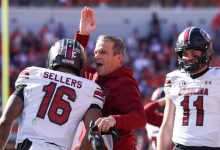LSU’s 2025 running back preview examines whether the Tigers’ rushing attack will improve with Caden Durham now leading the backfield.

The LSU Tigers football program has long been celebrated for its dynamic and formidable rushing attack, which has played a pivotal role in the team’s success over the years. As the 2025 season approaches, attention is turning to the future of LSU’s ground game, particularly focusing on whether the Tigers can elevate their rushing production with Caden Durham now taking the reins as the primary running back. This comprehensive analysis delves into LSU’s historical running game strength, Durham’s background and skill set, the competition within the backfield, coaching strategies, potential challenges, and the overall impact on LSU’s offensive identity. By examining these facets, we aim to determine if LSU’s run game will indeed be better in 2025 under Durham’s leadership and what factors will influence this outcome.
Historical Context of LSU’s Running Game
LSU has built a reputation for a powerful, physical running game that complements its aggressive defense. Throughout its storied history, the program has produced numerous elite running backs who have left lasting legacies, including Leonard Fournette, Derrius Guice, and Nick Brosette. These players exemplified LSU’s emphasis on a downhill, physical style of rushing, often wearing down opponents and setting up play-action passes.
In recent years, LSU’s offensive philosophy has continued to prioritize the run, especially under head coaches like Ed Orgeron and now Brian Kelly. The team’s offensive schemes have been tailored to maximize the talents of versatile backs, incorporating zone reads, power runs, and option plays. The run game has often been a cornerstone of LSU’s identity, enabling the team to control clock, impose physicality, and open up the passing game.
However, as college football evolves, so does LSU’s approach. The 2024 season saw some fluctuations in the run game’s effectiveness, partly due to injuries, roster changes, and the adaptation to new offensive coordinators. Despite these challenges, LSU maintained a commitment to establishing a strong rushing attack, recognizing its importance in SEC competition.
Caden Durham: Background and Skill Set
Caden Durham enters 2025 as a highly anticipated figure within LSU’s backfield. A talented and versatile running back, Durham’s emergence is viewed as a potential catalyst for an improved ground attack. To understand whether he can lead LSU to a more potent run game, it’s essential to examine his background, physical attributes, and skill set.
Background: Durham hails from a football-rich background, having starred at his high school with impressive rushing totals, agility, and vision. His recruitment profile was highly regarded nationally, with LSU securing his commitment due to his potential to contribute immediately.
Physical Attributes: Standing around 6-foot-0 and weighing approximately 210 pounds, Durham possesses the size and strength to break tackles and carry defenders. His lower-body strength and balance enable him to gain yards after contact, a trait highly valued in LSU’s physical offensive style.
Running Style: Durham is known for his explosive burst, vision in the backfield, and ability to accelerate through gaps. He exhibits a balanced combination of power and agility, allowing him to execute a range of running schemes—from outside zone to power runs.
Receiving Ability: In addition to his rushing prowess, Durham has demonstrated solid hands as a receiver out of the backfield. This dual-threat capability makes him an unpredictable element for defenses.
Intangibles: Durham’s football IQ, work ethic, and leadership qualities are often highlighted by coaches and teammates. His maturity and understanding of the game are viewed as assets that can help him acclimate quickly to LSU’s offensive system.
Competition Within the LSU Backfield
While Durham is poised to take on a primary role, the LSU backfield remains competitive, featuring a mix of experienced veterans and promising backups. The depth chart includes players such as:
John Emery Jr.: A seasoned veteran known for his burst and vision, Emery has been a productive back when healthy. His experience provides valuable leadership and reliability.
Armoni Goodwin: An explosive option with breakaway speed, Goodwin is capable of taking over games with big runs and offers a complementary skill set to Durham.
Freshmen and Newcomers: LSU continually recruits talented prospects who could push for playing time, including incoming freshmen with high athletic ceilings.
This competition is healthy, fostering a competitive environment that can elevate the overall run game. Durham’s ability to separate himself from these peers will hinge on consistency, performance in practice, and his ability to adapt to game situations.
Coaching Strategies and Offensive Philosophy
Under head coach Brian Kelly, LSU’s offensive philosophy emphasizes a balanced attack that leverages both the passing game and the run. Kelly’s background as a coach known for disciplined, versatile offenses suggests that LSU will tailor its rushing scheme to maximize Durham’s strengths.
Scheme Fit: LSU typically employs zone running schemes, allowing backs to read blocks and find cutback lanes. Durham’s vision and agility fit well within this framework, enabling him to exploit creases and extend plays.
Use of the Running Back: Kelly’s offense often features a committee approach, but with a clear lead back emerging as the primary rusher. Durham’s skill set makes him suitable for a featured role, especially if he demonstrates reliability and consistency.
Run-Pass Balance: A key to LSU’s success will be balancing the offense to keep defenses honest. Durham’s ability to be a threat in the passing game adds an extra dimension, making it harder for opponents to load the box against LSU’s run.
Adjustments and Flexibility: LSU’s coaching staff is known for adjusting game plans based on opponent tendencies and game flow. Durham’s versatility allows LSU to diversify its running schemes, keeping defenses off-balance.
Potential Challenges and Concerns
While optimism surrounds Durham’s potential to boost LSU’s run game, several challenges could influence the outcome:
Injury Risk: Running backs are susceptible to injuries, and durability will be crucial for Durham to establish himself as the lead back.
Line Play: The effectiveness of the run game depends heavily on the offensive line. LSU’s line must provide the necessary gaps and protection for Durham to succeed.
Consistency: Transitioning to a lead role can be demanding. Durham will need to maintain focus, avoid turnovers, and execute consistently.
Defensive Adjustments: Opponents will study LSU’s tendencies and adapt their defenses accordingly, potentially limiting Durham’s effectiveness if adjustments aren’t made.
Depth and Rotation: Even if Durham emerges as the primary back, LSU will likely continue using a committee approach, which can impact overall rushing volume and efficiency.
Impact on LSU’s Offense and Season Outlook
If Durham can capitalize on his skill set and the offensive line provides solid support, LSU’s run game could see significant improvement in 2025. A more effective ground attack would:
Open Up Passing Opportunities: A strong run game often draws linebackers and safeties closer, creating space for LSU’s receivers and quarterback.
Control Clock and Field Position: An improved run game enhances LSU’s ability to sustain drives and control the tempo of games.
Boost Player Confidence and Morale: A dominant rushing attack can energize the team and intimidate opponents.
Establish LSU as a Balanced Offense: Flexibility in attacking through both the air and ground makes LSU more unpredictable and dangerous.
Comparative Analysis: Past LSU Running Backs and Future Potential
Looking back at LSU’s history of elite running backs, Durham’s emergence as a potential game-changer echoes past success stories. Players like Fournette and Guice not only amassed impressive rushing yards but also brought physicality and explosive plays that defined LSU’s offense.
If Durham can replicate or exceed such performances, LSU’s 2025 run game could be among the best in the SEC and nationally. The key differentiator will be his ability to adapt to the team’s evolving offensive schemes and execute under pressure.
Will LSU’s Run Game Be Better in 2025?
Based on a thorough examination of LSU’s historical run game strength, Durham’s background and skill set, the depth of the backfield, coaching strategies, and potential challenges, there is a strong case that LSU’s rushing attack could indeed be better in 2025 with Caden Durham leading. His versatility, physical tools, and football IQ make him well-suited to take on this responsibility, and if he can stay healthy and adapt quickly, LSU’s run game could become a formidable force once again. Success will depend on the offensive line’s performance, the coaching staff’s ability to utilize Durham’s talents effectively, and the overall team health and cohesion. If these factors align, LSU’s 2025 ground game could surpass previous seasons, making the Tigers a more balanced, unpredictable, and dangerous offense capable of competing at the highest levels.









